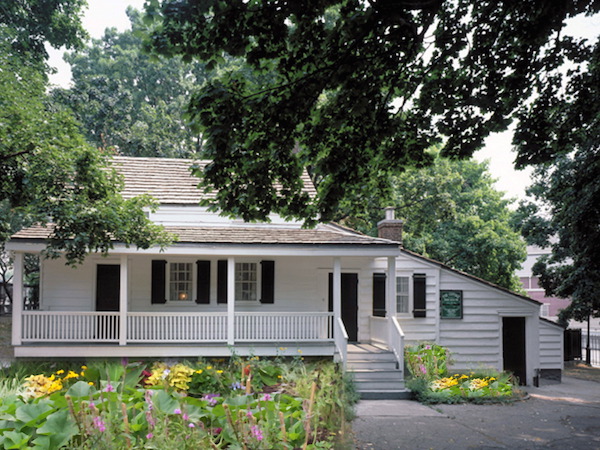
BY TRAV S.D. | I’ve only lived in New York for over 25 years — without ever getting around to visiting the Edgar Allan Poe Cottage, the home of one of my favorite writers. New Yorkers, you know the reason why. All together: “It’s in the Bronx!” Not because the Bronx is bad, but because it is far. From my house in Brooklyn, it’s nearly two hours away. It takes longer to get there than it takes to tour the museum. One strategy is to double your trip up with another nearby destination. I bundled my recent visit up there with a stop at the star-studded Woodlawn Cemetery. I highly recommend it.
The Edgar Allan Poe Cottage is maintained by the Bronx Historical Society. It’s where Poe lived and wrote from 1846 through his death in 1849, along with his child bride Virginia Clemm and her mother (who also happened to be his aunt — you do the math). Sadly, Virginia only lived there for a few weeks. Stricken with T.B., she perished on the premises. The bed where she expired is on view at the Poe Cottage. Most of the furniture, while historically appropriate, wasn’t part of the house when Poe lived there.
Poe only outlived his wife by less than three years. It’s safe to say he never ceased mourning. A lot of his time was spent wandering around the still-rural Bronx, traipsing the High Bridge, and walking to Fordham (then St. John’s College) to rap with the Jesuit priests. It’s melancholy to contemplate. His modest house was surely the farthest thing from a distraction — more like the lifestyle of a monk. (Yes, I know this was Poe — a certain amount of his time was no doubt spent at taverns!)
Still, I found the little cottage surprisingly bright and cheery, although I happened to be there on a sunny Sunday afternoon. But if you go there at night, who knows? There could be ghosts.
The tour guide at the little museum was terrific: enthusiastic, animated and knowledgeable. Much of what I’ve already included in this article came from him. He also pointed out some other cool stuff:
—A mysterious blemish in a period mirror in the shape of, I dare say, a raven.
—The house’s last remaining original pane of glass. Believe it or not, it’s fascinating, and the difference is noticeable (older glass is much less uniform and sheer, and full of swirls).
—An ironic newspaper clipping announcing Poe’s intention to start a new literary publication, The Stylus. The clip was from Oct. 7, 1849, the day Poe died while on a speaking tour in Baltimore.
Fans of Poe’s writing will be interested to know that this is the house where he wrote the poem “Annabel Lee,” about his deceased bride, and the impressionistic short story “Landor’s Cottage,” which some critics think may have been partially inspired by his home in the Bronx.
Above all, your main takeaway is that this man of limitless imagination, this national treasure, was a man of very modest means, and that is instructive. It’s been said that Poe was one of the first Americans ever to make his living entirely from writing. He was clearly just about able to eke it out. Support your artists while they live, ladies and gentlemen! That is the lesson I draw from the Poe Cottage.
The Edgar Allan Poe Cottage is owned by the New York City Department of Parks & Recreation, and operated by The Bronx County Historical Society, and is a member of the Historic House Trust. Hours: Thurs.–Fri. 10 a.m.–3 p.m., Sat. 10 a.m.–4 p.m. and Sun. 1 p.m.–5 p.m. Admission: $5 ($3 for students, seniors, children). Visit bronxhistoricalsociety.org and historichousetrust.org.
































